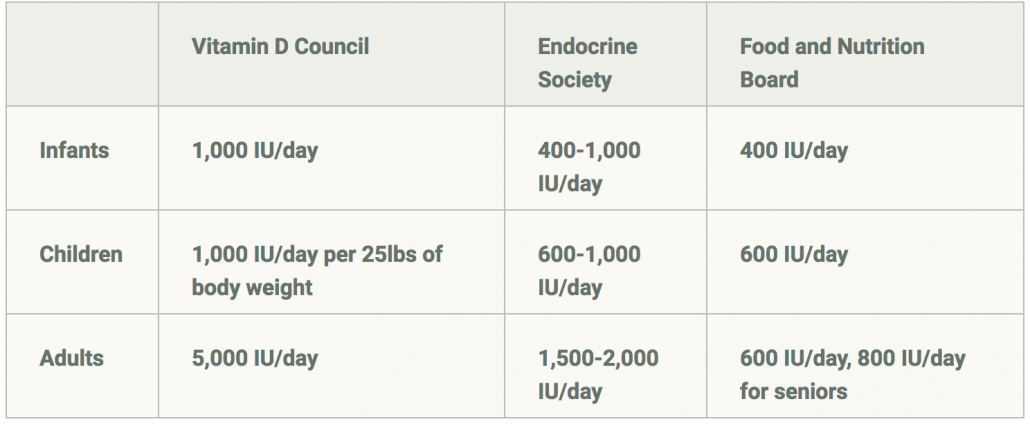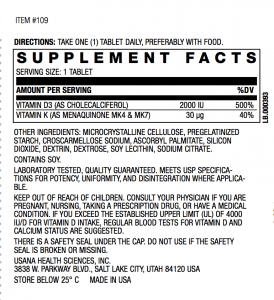Vitamin D: What You Need to Know
By: http://askthescientists.com/vitamin-d/
Vitamin D is necessary for normal bone mineralization and growth, maintenance of muscle strength and coordination, cardiovascular health, and robust and balanced immune function. Vitamin D is unique among vitamins working more like a hormone at the level of our DNA.Vitamin D has been estimated to regulate somewhere between 200-300 genes and likely why vitamin D has been linked to so many health outcomes.
Summary
- Vitamin D promotes a healthy, balanced immune system through regulation and differentiation of immune system cells.
- Vitamin D supports the development and maintenance of bones and teeth by helping with the absorption and use of calcium.*
- Healthy Vitamin D levels play a key part of minimizing age-associated bone loss.
- You can absorb Vitamin D naturally through foods such as fatty fish, egg yolks, and fortified cereals. Your body can also naturally absorb Vitamin D through skin exposure to sunlight. The more skin you expose, the more Vitamin D will be produced.
- Vitamin D deficiency is most directly related to poor bone health, including rickets and osteomalacia. However, vitamin D deficiency is also associated with an increased risk of other disorders, including certain cancers, type I diabetes, multiple sclerosis, tuberculosis, rheumatoid arthritis, muscle weakness and pain, depression, hypertension, and pregnancy complications.
- In the U.S., only one-third are getting adequate amounts of Vitamin D daily. USANA’s Vitamin D supplement is formulated with a high level of vitamin D to help prevent deficiency by ensuring you get adequate amounts throughout the entire year.
The Science of Vitamin D
Vitamin D promotes a healthy, balanced immune
system through its key role in regulation and differentiation of immune
system cells. It also has been linked to healthy endothelial function,
which is important for cardiovascular health. And, it also helps
maintain normal functioning of the nervous system.*
• Vitamin D may play a role in keeping our lungs healthy, with higher concentrations of vitamin D resulting in positive effects on lung function and health.*
• Vitamin D may play a role in helping elderly people maintain lean muscle mass.*
• Healthy vitamin D levels are a key part of minimizing age-associated bone loss.
Vitamin D supports the development and maintenance of bones and teeth by helping in the absorption and use of calcium.*
Calcium is the major structural element of bones and teeth. Your body needs several nutrients in order for calcium to be absorbed and used properly. Two of these nutrients are vitamin D and vitamin K. Vitamin D increases absorption of calcium from the small intestine so the body receives maximum benefit, while vitamin K helps make sure calcium builds up in the bones and not in soft tissues. Adequate calcium and vitamin D throughout life, as part of a well-balanced diet, may reduce the risk of osteoporosis.Natural Sources of Vitamin D
Food
There is a very small amount of vitamin D in a few foods, which makes it almost impossible to get the levels you need from food alone. However, some foods that include vitamin D are fatty fish, egg yolks, orange juice, and some cereals.Sun exposure
Every time we expose our bare skin to direct sunlight, we use ultraviolet B (UVB) rays to produce vitamin D3 (cholecalciferol). Sunlight can be a tricky thing, though, because too much can be a bad thing. You need to monitor how much sun exposure is needed for healthy vitamin D levels. The amount of vitamin D you actually absorb from sunlight differs depending on the time of day and year, where you live, and the color of your skin. The more skin you expose to the sun, the more vitamin D is produced. So those winter rays don’t necessarily produce the same amount of vitamin D that summer rays do.There are two main factors that determine how much Vitamin D your body will produce when exposed to sunlight:
Time of Day and Year
During the fall and winter months, the sun is at an angle that causes the atmosphere to lessen the amount of UVB rays that pass through. The same process occurs during the early and later parts of each day.
You can test this simply by looking at the length of your shadow when standing outside. If your shadow is longer than you are tall, not as many UVB rays are reaching your body, so you’re not producing as much vitamin D. This means that the closer to midday you are, the more UVB rays your body is getting. Have you ever noticed that in the winter months, your shadow is longer than you are for most of the day, but in summer, it is much shorter during the midday hours?
Where You Live
Take a look at a globe and find the equator. The further away you are from it means you are living in a location that makes it harder for your body to use sunlight to make vitamin D. Once again, this is because sunlight is hitting the atmosphere at more of an angle, blocking out more UVB rays, especially during the winter season.The Benefits of Vitamin D
Vitamin D status is a factor in the maintenance of good health. However, reports continue to show that populations around the world are suffering from vitamin D deficiency. In the U.S. alone, only one-third are getting adequate amounts of vitamin D daily. The problem is widespread and increasing, with potentially severe repercussions for overall health.Many cells in your body have vitamin D receptors and need vitamin D to function properly, including those in your skin and brain. USANA’s Vitamin D supplement is formulated with a high level of vitamin D to help prevent deficiency by ensuring you get adequate amounts throughout the entire year.
Vitamin D Deficiency
Deficiencies of vitamin D are common. It is currently estimated that more than 1 billion people worldwide and 30-to-40% of the population between 15 and 49 years of age in the United States suffer from vitamin D deficiency. Because relatively small amounts of vitamin D are obtained through the diet and so many lifestyle factors reduce endogenous vitamin D synthesis, supplementation becomes an important avenue for achieving and maintaining optimal vitamin D status.Vitamin D deficiency is most directly related to poor bone health, including rickets and osteomalacia. However, vitamin D deficiency is also associated with an increased risk of other disorders, including certain cancers, type I diabetes, multiple sclerosis, tuberculosis, rheumatoid arthritis, muscle weakness and pain, depression, hypertension, and pregnancy complications.
While many of these associations are actively being researched to determine the extent of their connection with vitamin D deficiency, we currently know that vitamin D unquestionably exerts a significant influence on many body systems.
Signs and Risk Factors of Vitamin D Deficiency
Feeling Down and Out
Turns out, when you run low on vitamin D, it takes a pretty serious toll on your mood. This is because our brains produce serotonin—a hormone that affects our moods—at a higher rate when we’re exposed to sunshine or bright light. And as I mentioned, more exposure to sunlight means more vitamin D.Skin Color
Those with darker skin are at a higher risk for vitamin D deficiency because skin pigment has a direct correlation with how much vitamin D is absorbed. Some research suggests that those with darker skin may need up to 10 times more sun exposure than those with lighter skin to produce a comparable amount of vitamin D.Age
Besides the fact that older people usually spend more time indoors, aging correlates to vitamin D deficiency in a couple of ways. First, the skin loses its ability to absorb as much vitamin D as we get older. And second, our kidneys slowly become less effective at converting vitamin D into the form used by our bodies.Sweat
Excessive sweating (specifically, on your forehead) is a very common symptom of those facing vitamin D deficiency. So if you’re constantly wiping the sweat off your brow (outside of the gym), you might want to look into getting a blood test done to check your levels.Achy Bones
Many people who are unknowingly deficient in vitamin D will complain of bones and joints that are achy or painful. This is because vitamin D is very important for maintaining strong bones. Calcium and phosphorus are essential for developing a healthy structure and strength of your bones, and you need vitamin D to absorb these minerals.Excessive Weight
Vitamin D is fat-soluble—meaning that the fat in our bodies is how we collect and store it. So if you’re overweight, the excessive amount of fat in your body needs a comparable amount of vitamin D to absorb. So you’ll need a lot more vitamin D than someone with a lower percentage of body fat.Gut Problems
Vitamin D is a fat-soluble vitamin. So certain gut conditions that cause a lower absorption of fat can also lower your absorption of vitamin D.How Much Vitamin D Do You Need?
It varies depending on where you look, but here is a chart of the recommended daily intakes from various organizations, brought to you by the Vitamin D Council.
VITAMIN D – IU TO MICROGRAM CONVERSION
1 microgram vitamin D = 40 IU vitamin De.g. 400 IU vitamin D = 10 mcg vitamin D
How Safe is Vitamin D?
Although vitamin D can be toxic in very large doses, toxicity is rarely the biggest cause for anxiety. Instead, deficiency has become relatively common. Vitamin D deficiency has been correlated to a number of health concerns.Because of the prevalence of deficiency, in the most recent revision of the Dietary Reference Intakes (DRI), the recommended dietary intake for certain age groups was increased as much as 50 percent. The tolerable upper intake level (UL) for vitamin D in adults is 100 mcg (4000 IU) per day.
There are no published accounts of vitamin D toxicity occurring as a result of sun exposure. Research also suggests that vitamin D toxicity is very unlikely at dietary intake levels below 1,000 mcg (40,000 IU) per day in healthy adults.
Vitamin D supplements do have the potential to interact with certain types of medications (including steroids and cholesterol-lowering drugs). Those taking medications should discuss vitamin D supplementation with their healthcare providers prior to use.
Talk to your doctor about healthy vitamin D levels, and ask for a test to find out if you are deficient.
The USANA Difference
Even when the winter months are behind us, it doesn’t mean your body needs less of a good thing. USANA’s Vitamin D supplement is a safe and easy way to get 2,000 IU of maximum-strength vitamin D enhanced with 30 μg of vitamin K.*
Frequently Asked Questions
Additional Resources
Vitamin D Deficiency: The Truth RevealedThe ABCs of Vitamin D
Scientifically Speaking: Got Vitamin D?
Uncovering the Benefits of Vitamin D
Vitamin D is a Supplement for All Seasons
| *These statements have not been evaluated by the Food and Drug Administration. This product is not intended to diagnose, treat, cure, or prevent any disease. |
|---|
References
- Vitamin D Council. https://www.vitamindcouncil.org/about-vitamin-d/how-do-i-get-the-vitamin-d-my-body-needs/
- Bischoff-Ferrari HA, Willett WC, Wong JB, Giovannucci E, Dietrich T, Dawson-Hughes B. Fracture prevention with vitamin D supplementation: a meta-analysis of randomized controlled trials. 2005. JAMA 293(18):2257-2264.
- Bodnar LM, Simhan HN, Powers RW, Frank MP, Cooperstein E, Roberts JM. High Prevalence of Vitamin D Insufficiency in Black and White Pregnant Women Residing in the Northern United States and Their Neonates. 2007. J Nutr 137:447-452.
- DeLuca HF. Overview of general physiologic features and functions of vitamin D. 2004. Am J Clin Nutr 80(6 Suppl):1689S-1696S.
- Feskanich D, Willett WC, Colditz GA. Calcium, vitamin D, milk consumption, and hip fractures: a prospective study among postmenopausal women. 2003. Am J Clin Nutr 77(2):504-511.
- Holick MF. Vitamin D: importance in the prevention of cancers, type 1 diabetes, heart disease, and osteoporosis. 2004. Am J Clin Nutr 79(3):362-371.
- Jackson RD, LaCroix AZ, Gass M, et al. Calcium plus vitamin D supplementation and the risk of fractures. 2006. N Engl J Med 354(7):669- 683.
- Jumar J, Muntner P, Kaskel FJ, Hailpern SM, Melamed ML. Prevalence and Associations of 25-Hydroxyvitamin D Deficiency in US Children: NHANES 2001-2004. 2009. Pediatrics 124:e362-e370.
- Looker AC, Pfeiffer CM, Lacher DA, Schleicher RL, Picciano MF, Yetley EA. Serum 25-hydroxyvitamin D status of the US population: 1988- 1994 compared with 2000-2004. 2008. AJCN 88(6):1519-1527.
- Papadimitropoulos E, Wells G, Shea B, Gillespie W, Weaver B, Zytaruk N, Cranney A, Adachi J, Tugwell P, Josse R, Greenwood C, Guyatt G. Meta-analyses of therapies for postmenopausal osteoporosis. VIII: Meta-analysis of the efficacy of vitamin D treatment in preventing osteoporosis in postmenopausal women. 2002. Endocr Rev 23(4):560-9.
- Saintonge S, Bang H, Gerber LM. Implications of a New Definition of Vitamin D Deficiency in a Multiracial US Adolescent Population: The National Health and Nutrition Examination Survey III. 2009. Pediatrics 123(3):797-803.




